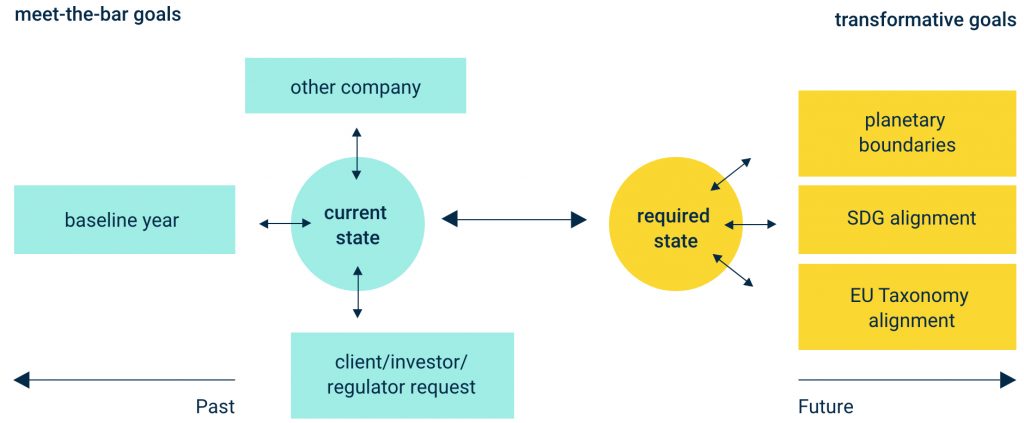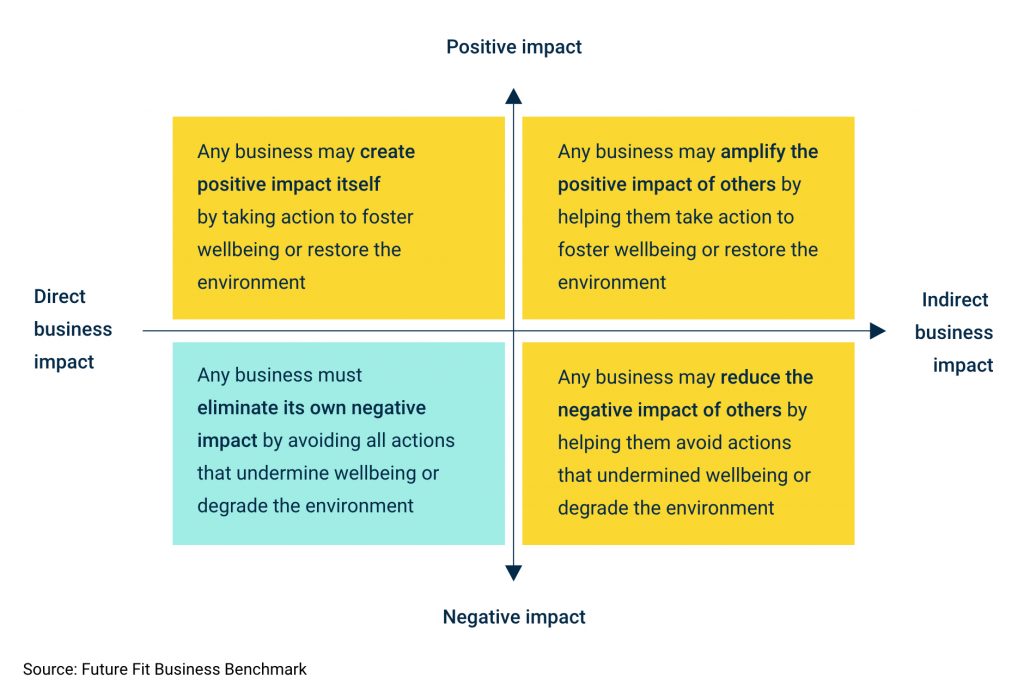Chapter 06
Strategize! How to reach for the stars.
Congratulations! By now you know which sustainability topics are material to your business and how they represent a business opportunity or a risk to your startup. What’s missing now is action. Guided action. Which means a strategy formulating specific, measurable goals as well as concrete actions to reach them. This chapter will help you to come up with such goals.
After this chapter, you…
- have your goals in place to reach for the stars – or at least, your sustainability ambitions
- know what you need to do to achieve your ambitions
Equilibrate your level of ambition
You know what they say: the hard thing about strategy is to draw a clear line between what you want to do and what you won’t do. But when it comes to sustainability strategies that’s only half the truth.
When you’ve come to this point in our playbook, you already know what you want to – or at least should – do in order to avoid future risks and/or capitalize on the opportunities. But you probably don’t know just how much it is you need to do. This is the hard part of strategizing on sustainability.
For the material risks you’ve identified, it is pretty straightforward: inaction can have economic consequences for you. And only little value will be added if you overinvest in addressing it. So, an ambition level that meets the bar (i.e. avoid the risks from occurring) should usually do the trick.
Meeting the bar can mean:
- Setting goals that meet specific requirements of your key stakeholders (e.g. clients expecting you to go carbon neutral for continued business)
- Defining goals for continuous improvement compared to a specific baseline year (make sure that you work with relative KPIs – e.g. CO2 emissions per employee – to account for your expected growth)
- Comparing your goals with those of your peers (big industry players or other startups)
For sustainability topics representing a business opportunity, the appropriate ambition level is not so easily defined. In most cases, it will depend on the sustainability topics and the associated opportunities themselves.
However, in a world that substantially invests in combating climate change and reaching the SDGs, tangible business upsides will most likely be found in transformative goals.
Such goals can usually be found in:
- Going for zero (eliminate your negative impacts by fully avoiding them in the first place or by offsetting if further reductions aren’t possible)
- Altering or evolving products and services catering to the needs of humanity living within the planetary boundaries
- Targeting new markets or clients whose sustainability performance could be substantially improved by your product or service
Understand your impact potential
Next to defining an appropriate level of ambition, another important part of the strategy puzzle is to understand the different ways how you can actually create impact: you can either reduce your negative impacts or strengthen your positive impact. Either way can minimize risks and/or leverage opportunities.
You should also be aware that you can influence any impact you create either directly or indirectly. Directly, by pushing your own boundaries, and indirectly by helping others to do better or less bad.
As you can see in the two-by-two above, there are plenty of opportunities to capture not only from strengthening your direct and indirect positive impacts, but also by finding ways to indirectly reduce the negative impact of others.
Break-Even Goals and Positive Pursuits
The Future-Fit Business Benchmark provides a lovely differentiation for these two different categories of goals: Break-Even Goals and Positive Pursuits.
Break-Even Goals collectively represent the line in the sand every business has to reach in order to usher in a more sustainable society – and to avoid the business risks accompanied by that transition. Positive Pursuits, on the other hand, encompass any activity beyond break-even whose outcome can speed up the transition to a sustainable society – and create competitive advantages.
This resource (Future-Fit Business Benchmark) lets you explore a plethora of potential goals for your material issues of the SDGs you may have prioritized.
With this, you are all set up to define the core goals for your material issues:
- Think about the appropriate level of ambition
- Understand the nature of the impact you want to make
- Define your goals for incremental improvement or transformational change
Make an action plan
Once you have defined your goals, you need to draft an implementation plan to actually activate your strategy.
For this purpose,
- You need to think about measures that enable you to reach these goals in the first place (e.g. implementing a measurement scheme to assess the status quo, draft a long-term investment plan, or building the required knowledge and resources).
- Secondly, once you have created the necessary enabling conditions, you can define milestones to achieve your target (e.g. switching to renewable energy within the next year and offsetting the remaining carbon emissions one year later).
Always being one step ahead of our competitors. Doing our best to become the most environmentally-friendly drive system for e-bikes.
– Fazua’s vision
Case Study: Fazua
In the summer of 2020, Fazua set out to work on a holistic vision and strategy for its startup.
Together with SYSTEMIQ and UVC Partners, they first developed their systems map (read more in chapter 3) and identified their material issues, as well as opportunities and threats to their business. Then they derived their objectives and action plan for the next five years.
Here you can find Fazua’s sustainability strategy (download)



